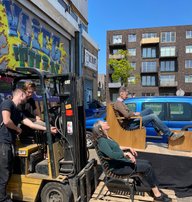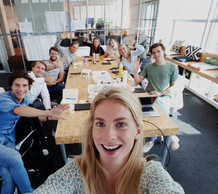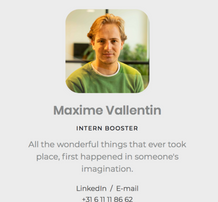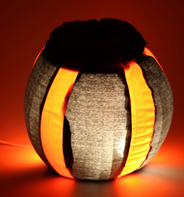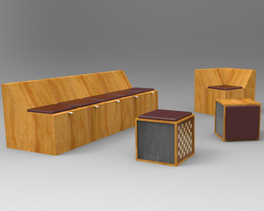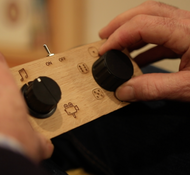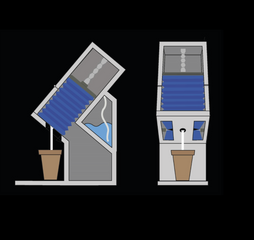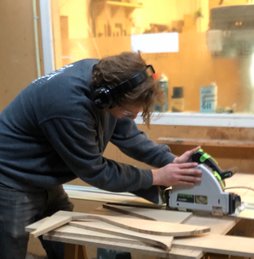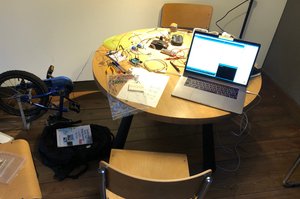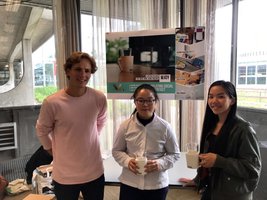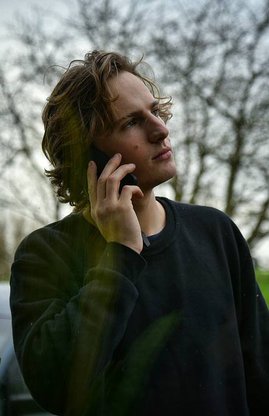PAST
In this section I evaluate my development in the different competence areas of Industrial Design.
User & Society
From a young age, I have been interested in the systems of society and ethical issues. I am and always have been a sensitive and social person who greatly values connection and interaction. However, my skill sets regarding this area have nevertheless greatly strengthened during my time at Industrial Design.
The first specific course I took on this subject was User-Centred Design. During this course, I developed an understanding of usability and user experience and learned to work with some specific methods and tools such as creating personae. Moreover, I got to create my first low-fidelity prototype which gave the opportunity to try usertesting and integrate the obtained insights during the process. The course provided me with the first tools to go through a structured and logical process of user research and user testing.
The second course I took in my first year was the course User Evaluation Methods. In this course, I could deepen my recently obtained knowledge on user test methods from User-Centred Design and learn new ways to do this effectively. This concerned both qualitative as quantitative user tests. Moreover, I learned how to research a targeted user group in practice, in a scientific way.
The skills I obtained during these two courses were greatly useful for Project 1, in which I applied everything I learned from User Evaluation Methods.
The third relevant course for this expertise area was Cultural sensitivity, which focused on the effect and influence a design can have on society. This showed me the relevance of awareness of societal tendencies and integrating this in the design. In the course USE basics, this awareness was reiterated and thus strengthened on the level of engineering. This taught me about the ethical issues designers and engineers have to deal with and provided me with insights that I personally value in society.
In Project 2, my teammates and I did a lot of user tests, both with low-fidelity and final prototypes during the entire process. Moreover, we also executed both quantitative and qualitative research. In sum, we used all the information from the year before to create a design that fit the users’ needs as well as possible.
Business and Entrepreneurship
Since I have been working as a freelancer in the film and lighting industry for quite a long time, I kept developing my insights on the working world. I knew how to deal with clients and to run myself as a freelancer. Moreover, I organised multiple events in the same sector. This way, I gained knowledge on finance and communication with regard to services. I did not yet do anything with products yet, as I would be doing at Industrial Design.
During Project 2, I worked with the business element of design for the first time. Amongst others, I took a workshop from Mitchell Jacobs. In this, I got introduced to the helpful tool Business Model Canvas and the Benchmark which I immediately applied in my project.
The same year, I got to put my knowledge to the test during the organisation of Conduct. As the chairman of the board, I had contact with many partners at the same time and learned more about clear communication and event management. Moreover, I was partly responsible for the budget. With this, I learned how to divide the available means while getting the most for your money.
Next, I got to put my knowledge to work when doing my Internship at Innovation Booster. This gave me valuable insights on business and entrepreneurship in practice. They used various kinds of models and tools which I now know and can use. Moreover, I worked with big and/or commercial companies through Innovation Booster. Because of this, I now have a greater understanding of the systems and standards of the corporate world.
These aspects of valuable practical knowledge were a great help to improve my skill set in this area. However, I did learn about only one kind of method fitting one kind of company. With the course Introduction to Business Design, I could broaden my knowledge. This course provided me with information on various but essential elements, namely market, intellectual property, branding and finance. My teammates and I dove into four different companies and analyzed the way they handled a certain element of business. This taught me a lot about different ways to handle different problems.
To further expand my understanding of business and entrepreneurship, I took the course Design with and for multiple stakeholders. During this course, I learned about a few new models such as the Value Flow model, the Board of Innovation and the Value Framework. These tools gave me and my teammates insights on the structure around and potential of our product. Moreover, they provided me with helpful frames to fill in in order to approach stakeholder networks in a new way and thus to find out about connections and roles we had not thought about ourselves.
To learn about the last components of Business & Entrepreneurship, I took the course Design Innovation Methods. In this course, we both had the opportunity to apply models and canvasses already known to us and learned about new methods. Amongst others, I created two Business Model canvasses and a Get-Keep-Grow analysis. With this, I feel like I properly concluded my theoretical development in the Business and Entrepreneurship area. From now on, I will keep improving by putting my knowledge to work in practice.
Creativity and Aesthetics
The first ever design course I took was From Idea to Design. I learned about the first concepts of creative designing. I got introduced to and practiced with the concept of ideation, brainstorming and narrowing. After this very broad introduction, the next creative process was during Project 1. With this, I continued the broad introduction and gained an understanding of new techniques like mapping and pressure cooking.
During Project 2 and 3 I learned about and applied new brainstorm techniques. My teammates and I came up with three different concepts using three different techniques like mind mapping and reverse brainstorming.
After building a base in this area, I took the course Engineering design in which I was responsible for the aesthetic of the design. This taught me how to cooperate with other experts while still maintaining my standard of aesthetics and creativity. This was the first time I integrated the shape of the object into the logo of the design. With that, I created an appreciation for branding of a design with the technicalities connected to it and implemented in it. This showed me that it is possible to upgrade something purely technical by adding something lively and fun to it.
During the courses Aesthetics of Interaction and Perspectives on Aesthetics I got introduced to various elements of a design that influence the aesthetic looks. Moreover, the courses strengthened my knowledge on different perspectives on aesthetics and I developed a more critical attitude towards the concept. During the processes, I created a balance between designing from my intuition and based on the knowledge gained in the various courses.
Technology and Realization
During almost all of my projects, I was the one responsible for and the creator of the prototypes. I feel like this area is partly about knowledge and partly about experience. Because I have created so many prototypes, the details and workmanship of my prototypes kept improving. This caused a great development in my skill set in the expertise area Technology and Realization. In the course From Idea to design, I got to work with woodworking machinery in the architecture building for the first time.
With regard to computing, I got introduced to the essentials during the course Creative programming. This was a basic learning experience with Arduino and Processing. Next, during Creative Electronics, I learned my first specific abilities to weld and work with electronics.
To extend my skills in this area, I worked in the materiality lab (textile) for the first time during Project 1. I took an introductory course for this. Moreover, I learned how to work with SOLIDWORKS and the 3D-printing machinery. During Engineering Design, I practiced with realisation during the creation of the prototype. Amongst others, I used new kinds of sensors and realized an interaction.
During the course Technologies for Connectivity, my teammates and I built an IOT system for the first time. Moreover, I had lectures on using the proper codes and common issues with big coding systems. I valued the practical information this course provided, such as using and connecting systems via an IPA.
Math, Data and Computing
The courses Calculus and Physics provided me with a good starting point in understanding the field of math and data. Next, the course User Evaluation Methods taught me about essential theories and concepts with regard to data collection and analysis. An example is the z-score.
Introduction to Modelling and Data analytics deepened my knowledge and understanding digital data handling and modelling. Moreover, I learned to program in python and select data in a proper way.
During Project 3 I learned a lot in this area. It is the first project where I have learned to work with very large quantities of numbers. For our Auping assignment, we measured various mattress techniques and used different methods for different measurements. During the measurement we have collected values every two seconds. This gave us an enormous amount of data that needed to be processed. I have learned how to process these large amounts of data in Excel.
In the course Making Sense of Sensors, I got to use my theoretical knowledge on data handling. By creating an at-home measuring system, I collected various kinds of data and practiced analyzing these and drawing conclusions.
The course Interactive Intelligent Products gave me and my team the opportunity to create a self learning algorithm which we trained with pictures. Data was collected through an Arduino and a Processing sketch. This resulted in the design of an interactive elastic band placed around the chest that measures whether someone is performing a yoga pose correctly.
Moreover, during all the design processes I went through, I constantly practiced and improved my skills to analyze and communicate obtained data. These skills have supported me throughout to deal with data collected from user tests and/or observations.
Professional skills
During the course Engineering Design, I practiced working with students from different studies who mostly had a different focus. They, for example, were not that interested in Creativity or Business, whereas that was and is greatly relevant for me as a designer. With this assignment, I got to understand that it is perfectly fine to delegate some tasks but also of importance to try to involve everyone in important issues.
As the chairman of the Conduct committee, I had to stay in touch with various stakeholders and/or partners at the same time. For me, this amongst others emphasized the relevance of following up after unanswered communication and checking everything properly. Moreover, I had to lead a group of more than twelve people, from which I learned to delegate properly. I normally struggle with this since I value details and control greatly. This project helped me to learn to motivate others to work hard and meet their deadlines.
During Project 3, I got to work with and for a client for the first time. This taught me how to maintain a comfortable connection with the partners and how to present an idea. Later on, I also got to collaborate with Unicef which taught me what it is like to work with a global non-profit organisation with a societal cause.
At my Internship at Innovation Booster, I developed my skills in presenting, communicating in a workspace and writing in a formal way.
In the various design research processes I went through, such as Project 3, I improved my skills on writing an academic report based on scientifically correct information, including the proper referencing style. Moreover, I got to learn how to reflect on my own attitude and work in the right way.
In general, I improved my English academic writing and speaking skills during the entirety of my study. This is obvious from the texts I wrote when I was in the first year and the texts I am writing now.
Design and Research processes
I greatly value this competence area because I think going through the proper steps to create a logical and smooth process. This way, the most can be gotten out of the design solution. Moreover, I consider a good process as something very comfortable and satisfying because it helps to get everyone in check and not forgetting essential elements.
During the entirety of my Industrial Design study, I went through various design and/or research processes with different takes. More often than not, I would take on a proactive leading role in these. This mostly happened at times when I had the best overview of tasks and the best social skills. Nevertheless, with time, I improved my skills to delegate and leave other people to do their tasks.
In the course Design <> Research, I became familiar with multiple new design methods and deepened my knowledge on various research theories, such as the mixed methods approach.
Empathy with the User gave me the opportunity to properly deepen my knowledge of Design Thinking and the Double Diamond. In various courses and projects afterwards, I applied these methods and through working with them discovered the way I work best with every method.

